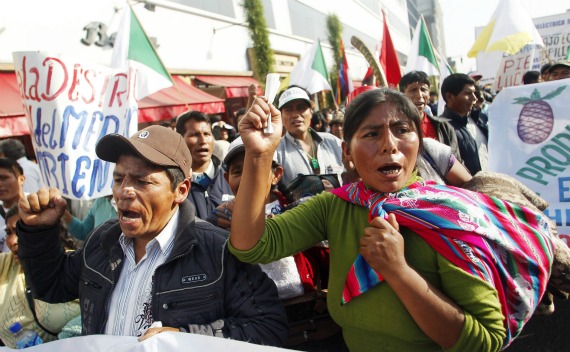Peru’s Balancing Act: Indigenous Rights and Economic Development
More on:

Last month Peruvian President Ollanta Humala signed the popular consultation law, approved unanimously by Congress in August. This new law will require all public and private investors to consult local indigenous groups if and when their activities may affect their communities or ancestral lands. This is an important democratic step forward, reaching out to citizens who have for years been left out of the political process. In Latin America more broadly, incorporating indigenous communities into politics is a key challenge for consolidating democracy. But these types of laws also have their dangers, specifically potentially negative effects on investment and economic growth. Peru is only the latest of the Andean countries to take on the so-called “indigenous question” -- trying to balance economic development with greater social inclusion.
Of its neighbors, Colombia has the longest history and the best track record. It incorporated indigenous consultation into the 1991 Constitution, and then created a Division of Indigenous Affairs in the Ministry of the Interior, as well as offices of indigenous affairs within each of its military commands. To be sure, things haven’t gone perfectly – for instance some indigenous groups accuse President Santos of ignoring their interests in the latest national development plan. But overall Colombia has been successful, enabling a greater voice for all of its citizens while also attracting billions in investment in oil production, coal mining, and other industries.
More cautionary tales come from Bolivia and Ecuador. Both nations have large indigenous populations which historically have been socially and politically marginalized, and excluded from the economic benefits of resource extraction -- often by foreign companies -- taking place on their land. As these groups have increasingly organized and mobilized, their distrust and animosity has led to conflicts, violence, and the fall of more than one democratically elected government.
Current Presidents Evo Morales of Bolivia, and Rafael Correa of Ecuador have both struggled to balance inclusion with economic development. Morales has perhaps gone the farthest in providing a voice for indigenous groups within the new Constitution, but in return has seen foreign investment plummet. Since Morales’s election in 2006 Bolivia’s natural gas output has stagnated, and proven reserves have shrunk by about a third. In Ecuador, Correa began with the backing of the Confederation of Indigenous Nationalities of Ecuador (CONAIE), but is now at odds with the country’s largest indigenous organization, backing away from many of their demands regarding new mining projects.
While Peru’s indigenous communities have yet to organize politically, there is a growing discontent among these masses, which took a toll on the previous government’s popularity and led to several uprisings around natural resources extraction. The most violent of these – known as the “Baguazo” – occurred during the summer of 2009 in the Amazonian province of Bagua, where 22 indigenous protesters and 12 police officers died in clashes over mining projects in the area.
For Peru, it remains to be seen whether Humala can channel these pent up frustrations positively into the political process without scaring off investment. As the Ecuadorean and Bolivian examples show, more than just rhetoric -- or leftist credentials -- are needed. But if the new government can pull off this delicate balance, it will help support continued fast paced economic growth.
More on:
 Online Store
Online Store